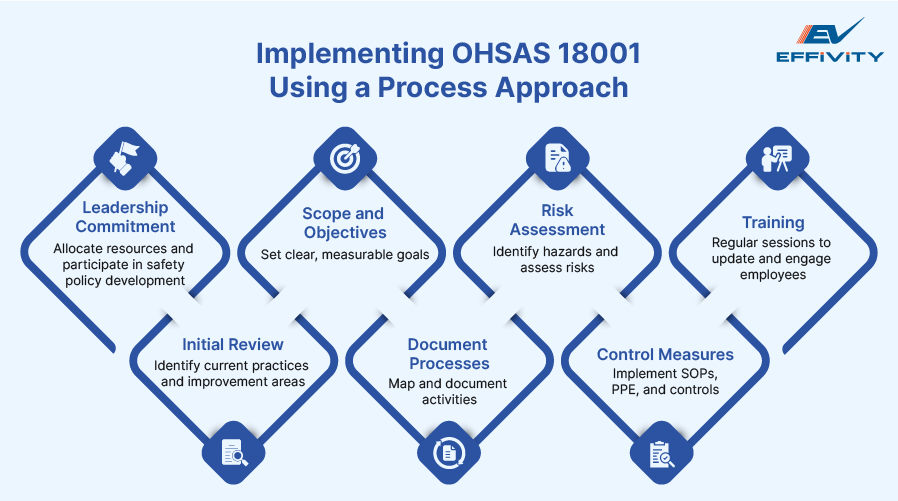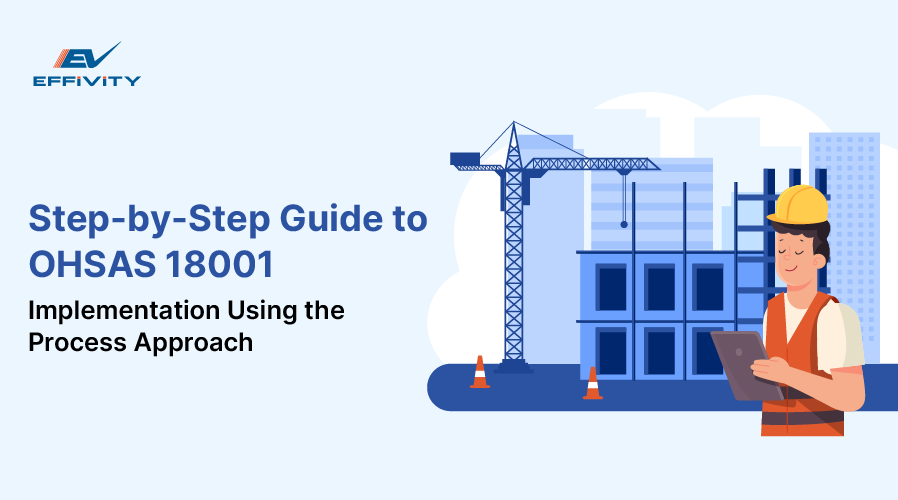Every employee wishes to feel safe and secure when they are at work. The good news is that the benefits of ensuring their safety go beyond just an obligation. Your organization enjoys several tangible benefits when employees feel safe. In a secure environment, employees are more productive, loyal, and engaged. In
OHSAS 18001 gives you a framework for managing workplace safety. With a process approach, you can systematically implement this framework, identify issues, and control hazards.
In this article, we will see how you can use the process approach to implement OHSAS 18001 effectively and use health and safety management software to simplify the process.
What is the Process Approach?
The process approach is a set of managing activities in your organization as interconnected processes. Instead of treating tasks in isolation, you look at how each process impacts others. This approach helps you identify the flow of work and ensures that everything runs smoothly and efficiently.
By using the process approach, you can identify areas for improvement more easily. It lets you see where bottlenecks occur and where resources might be wasted. You can then make information-backed decisions to enhance overall performance and safety.
Applying this approach to health and safety management means you'll map out each step of your operations. This way, you can pinpoint potential hazards and implement effective control measures. It's a straightforward way to boost safety and efficiency.
Implementing OHSAS 18001 Using a Process Approach
Implementing OHSAS 18001 using a process approach ensures a structured and efficient way to manage workplace safety. This method involves systematically planning and executing steps to identify, control, and improve processes that impact health and safety. A process approach helps in achieving compliance with the OHSAS 18001 standard and creates a culture of continuous improvement within the organization.
The process approach breaks down the implementation into manageable steps, making it easier to integrate health and safety management into everyday business operations. Each step builds on the previous one to keep the system moving forward.

1. Commitment from Leadership
Leadership commitment is the foundation of successful OHSAS 18001 implementation. It begins with top management recognizing the importance of health and safety and allocating the necessary resources. Leaders must actively participate in developing the health and safety policy, setting objectives, and reviewing performance.
Involving leadership helps to establish a clear direction and demonstrate the organization's dedication to health and safety management. This commitment should be communicated with all the stakeholders in the organization. Regular meetings and updates from leadership can reinforce the importance of the OHS system.
2. Initial Review and Gap Analysis
An initial review and gap analysis help understand the present state of health and safety practices. This step involves examining existing documentation, procedures, and controls. Comparing these with the OHSAS 18001 requirements highlights areas that need improvement.
Conducting a thorough gap analysis provides a baseline for planning the implementation. It identifies strengths and weaknesses, helping to prioritize actions. This step is critical as it sets the stage for targeted improvements and resource allocation.
3. Define Scope and Objectives
Defining the scope, vision, and objectives of the health and safety management system ensures clarity and focus. The scope outlines the boundaries of the system, including physical locations, activities, and personnel involved. Clear objectives provide measurable targets for improvement.
Objectives should align perfectly with the organization's overall goals and be specific, measurable, achievable, relevant, and time-bound (SMART). Defining the scope and objectives helps in structuring the implementation process and provides a clear direction for the organization's health and safety efforts.
4. Identify and Document Processes
Identifying and creating thorough documentation for processes is a crucial step in the process approach. This involves mapping out all activities that impact health and safety, detailing inputs, outputs, and interactions. Documentation should include procedures, work instructions, and responsibilities.
Creating detailed process documentation ensures consistency and helps in maintaining control over health and safety activities. It also aids in training and communicating expectations to employees. Process maps and flowcharts can visually represent the steps needed and are easy to understand and follow.
5. Risk Assessment and Hazard Identification
Risk assessment and hazard identification are core components of health and safety management. This step involves identifying potential hazards in each process and assessing their impact on health and safety. Various tools, such as HAZOP (Hazard and Operability Study) or FMEA (Failure Modes and Effects Analysis), can be used.
Assessing risks helps prioritize control measures to mitigate them. Documenting identified hazards and their associated risks ensures that no potential danger is overlooked. Regular risk assessments must be performed to address any changes in processes or the working environment.
6. Develop and Implement Control Measures
Developing and implementing control measures is essential for managing identified risks. Control measures can include engineering controls, administrative controls, and personal protective equipment (PPE). Standard operating procedures (SOPs) should be created to guide these measures.
Implementing control measures requires training employees and ensuring they understand their roles in maintaining safety. Regular inspections and audits help in verifying the effectiveness of these measures. Proper documentation and communication of control measures enhance compliance and safety awareness.
7. Training and Awareness
Training and awareness initiatives define the basis for the successful OHSAS 18001 implementation. Employees should be trained on the requirements of the standard, the specific health and safety procedures, and their roles in the system. Regular training sessions make sure that everyone is up to date with the latest practices.
Creating awareness about health and safety fosters a proactive safety culture. Employees who understand the importance of safety are more likely to follow procedures and contribute to a safer workplace. Training materials, workshops, and awareness campaigns can be used to engage employees effectively.
Key Process Approach Benefits
Adopting a process approach in health and safety management provides numerous advantages. It streamlines operations and enhances overall workplace safety and efficiency.
-
Improved Efficiency:
Identifying and managing processes allows for smoother workflows. It reduces redundancies and minimizes delays, leading to more efficient operations. -
Better Risk Management:
Understanding process interactions helps in identifying potential hazards. You can implement targeted control measures to mitigate risks. -
Enhanced Compliance:
A process approach aligns with regulatory requirements more efficiently. Documenting processes ensure compliance with standards like OHSAS 18001. -
Continuous Improvement:
Ongoing monitoring of processes promotes continuous improvement. Identifying weaknesses and making necessary adjustments enhances performance. -
Employee Engagement:
Clear processes and roles improve employee understanding and involvement. Training becomes more effective, and employees are more likely to follow safety protocols. -
Cost Savings:
Efficient processes and effective risk management reduce costs associated with accidents and downtime. Investing in preventive measures lowers long-term expenses.
Final Thoughts
Using a process approach in health and safety management creates a safer and more efficient workplace. It helps with better risk management, continuous improvement, and cost savings. Employees become more engaged, leading to a strong safety culture.
Implementing OHSAS 18001 can be complex, but using specialized software simplifies the process. Software tools streamline documentation, monitoring, and reporting. They provide real-time insights and automate compliance checks, making it easier to maintain standards.
With OHSAS software, you can efficiently manage health and safety processes. It reduces administrative burdens and ensures consistency across the organization. This makes it simpler to achieve and maintain OHSAS 18001 certification.





















